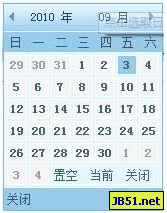Home >Web Front-end >JS Tutorial >Dynamically load image paths and maintain the relative independence of JavaScript controls_javascript skills
Dynamically load image paths and maintain the relative independence of JavaScript controls_javascript skills
- WBOYWBOYWBOYWBOYWBOYWBOYWBOYWBOYWBOYWBOYWBOYWBOYWBOriginal
- 2016-05-16 18:20:251049browse
There were three methods considered at the time:
1. Write the path directly in the js file, but if the path level of the reference page changes, there will be no solution.
2. Write a class and put it in the css file in the theme package or create a separate css file specifically for the date control. However, there is no need to use classes for other elements in the control. Creating corresponding CSS documents separately seems to be a big deal.
3. After excluding the above two methods, it is natural to use the method of dynamically loading the image path.
The key code is as follows:
Copy code The code is as follows:
//Create a global Variable saving path
var imgRootUrl = "";
//Get the directory where the image path is located
var strPath=window.document.location.pathname; //Get the directory part after the host address
var thisUrlCount = strPath.split('/');
var hierarchyOfFolders = thisUrlCount.length-2;//Get the directory hierarchy
for(iRoot=0;iRoot
imgRootUrl ="../";
}
imgRootUrl ="Images/"; //This Images can actually be set as a parameter. Since the naming of all project image folders is fixed, there is no parameter set, but Still save scalability.
After adding the image, the control effect is quite beautiful:

By the way, attach all the properties of window.document.location:
document.location.hash // The part after # VS window.location.hash
document.location.host // Domain name port number
document.location.hostname // Domain name
document.location.href // Full URL
document.location.pathname // Directory part (application)
document.location.port // Port number
document.location.protocol // Network protocol (http:)
document.location. search // The part after ?
Statement:
The content of this article is voluntarily contributed by netizens, and the copyright belongs to the original author. This site does not assume corresponding legal responsibility. If you find any content suspected of plagiarism or infringement, please contact admin@php.cn
Previous article:How to set the background color and font color of a column in extjs grid_extjsNext article:How to set the background color and font color of a column in extjs grid_extjs
Related articles
See more- An in-depth analysis of the Bootstrap list group component
- Detailed explanation of JavaScript function currying
- Complete example of JS password generation and strength detection (with demo source code download)
- Angularjs integrates WeChat UI (weui)
- How to quickly switch between Traditional Chinese and Simplified Chinese with JavaScript and the trick for websites to support switching between Simplified and Traditional Chinese_javascript skills

